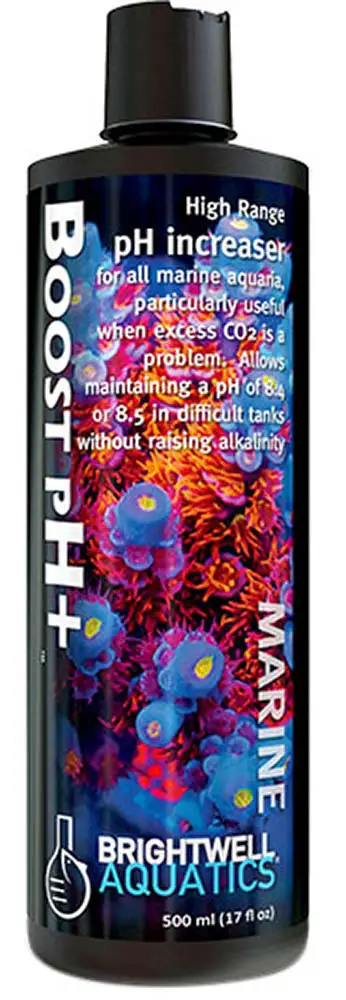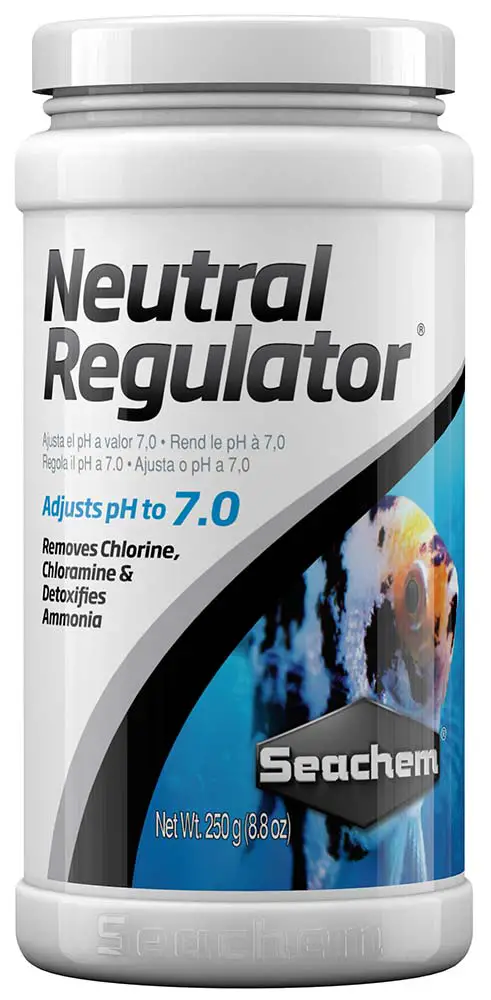One of the most important measurements you need to monitor in your aquarium is the pH of the water. Knowing what to do when the pH is too high or too low is just as important as knowing how to properly feed your fish.
How to raise the pH in your reef aquarium
Raising your pH is relatively straightforward, but the method in which you choose to raise pH levels in your tank will depend on what component might be lacking in your aquarium water. Here are some of the ways that you can explore to help find the ideal pH level for your aquarium fish.
Warning: Fish are extremely sensitive to large changes in pH, so it might be best to remove your fish and quarantine them while you try to stabilize the main tank.
Maintaining alkaline levels
Alkaline helps to regulate the acidity of the water and allows for higher pH levels. You can use sodium bicarbonate mixed with some water to raise the alkaline levels in your fish tank. Try to find packaging that is just labeled sodium bicarbonate if you would like to save some money. There is nothing too fancy in this process since it is pretty simple.
Alkaline goes hand in hand with calcium as both will be used during this process. Tank’s that are able to accurately monitor both of these components will have much more consistent pH levels. There are some mixes that come with both calcium and sodium carbonate. There are even supplements you can try to use to lower carbonic acid in your tank to change the pH levels.
Try using a refugium
Raising pH levels doesn’t have to involve adding chemicals and supplements to the water to affect the water quality; you can also try using a refugium that is using macroalgae to help reduce CO2 levels from the aquarium. Lowering the CO2 will help to increase the pH in your reef aquarium. Plus, the refugium can help with other aspects of your tank’s water quality.
Try to reduce CO2 in other ways
If you believe carbon dioxide is your true problem while trying to raise your pH levels, then you might want to try to reduce the levels of the gas around the tank and skimmer. Your protein skimmer, in particular, might be the most to blame due to potentially high gas exchange from the equipment.
If it is possible with where your aquarium is located, you might try to run an air tube from outside to the protein skimmer. Word of warning: make sure that your air tube is not sucking in air from a place outside that might introduce more issues to your tank!
However, if that method seems a little too DIY, then you should opt to use a CO2 scrubber which helps to alleviate the CO2 levels in your tank by removing the gas before it even gets to the protein skimmer. With this method, though, you should monitor the pH levels carefully as the scrubber can be very effective in reducing C02 levels. If you are trying to raise the pH in your aquarium, it is possible to overshoot your mark if you are not careful.
Baking soda
Another easy at-home solution for increasing your pH levels in your aquarium is using baking soda. The pH of your tank can be improved by using about 1 teaspoon of baking soda for every 5 gallons of water. Dissolve the baking soda in tank-ready water and throw it in—Monitor the tank water for any changes.
Add some new decor
By decor, I am not referring to a sunken pirate ship but instead, try adding shells or rocks to help raise the pH in your fish tank. Crushed coral can do wonders for your tank’s pH. Don’t like the appearance of crushed coral in your tank? Then try hiding them. You can put them in hard-to-see places in your live rock formations or find a place in your filter where they might be able to do their job.
How to lower the pH in my fish tank?
Lowering the pH is arguably much more difficult than simply raising it. You might need to perform some trial and error when lowering the pH in your tank, as some of your efforts might prove ineffective at first. Here are a few useful methods you can try to help lower the pH in your aquarium.
Add CO2
If you have been paying attention, then it should make perfect sense why adding CO2 to your aquarium will help lower the pH in your reef aquarium. There is a direct relationship between the two, so as one is raised, the other is often lowered. Monitor the tank water for any changes. This can be done with liquid fertilizers.
Add Soda Water
Adding soda water is essentially just another method of adding CO2. Soda water is just carbonated water so adding soda water to your aquarium will release the carbon dioxide in the soda into your aquarium water.
Add Distilled White Vinegar (5% Acidity)
When distilled white vinegar is added to your aquarium the acetic acid goes through a reaction that converts it to carbon dioxide and in turn lowers the pH. The formula suggested for adding distilled vinegar is 1 ml/gallon to reduce pH by 0.3. The vinegar should be added very slowly and done so as far away from fish, corals, invertebrates, etc. as possible, such as in your sump. This will give it time to dilute before coming into contact with the inhabitants of your aquarium.
This process does lower oxygen in the water so it is smart to ensure your protein skimmer or some other method of aerating the water is helping provide oxygen back into the water.
Commercial Solutions
If you are struggling to lower the pH, consider adding chemicals to the aquarium to make the necessary adjustments to get the ideal pH. Many products on the market for adjusting pH are designed to raise pH but SeaChem Neutral Regulator is designed to bring pH specifically to 7.0.
How to maintain an aquarium's pH
Honestly, the best way to maintain your aquarium’s pH is to follow a consistent maintenance routine. make sure you are carrying out regular water changes and properly treating your tap water before you add it to your fish tank. The rest is getting to know your aquarium and species of fish.
As your work with them, you will begin to realize its weak areas so you can better compensate. Should you lower the pH regularly by adding peat moss? That will depend on whether your fish tank appears to have a high pH regularly. The same can be said if the levels are too low.
What is pH, and why is it important?
You may remember a thing or two from your days in Biology class about how pH is a measurement of the acidity in a liquid. To put it more scientifically, pH is the measurement of the Hydrogen ions that are present in the liquid. However, how exactly does it factor into your fish tank? To ensure that your coral and fish are able to thrive within your tank, they need the pH of your aquarium to be within a particular range that fits their needs. The pH level can have drastic repercussions if you are not monitoring it appropriately.
As your pH begins to drop, compounds like ammonia and nitrites may begin to rise, which can cause your tank to cycle again. What usually happens when this happens is that your tank’s inhabitants begin to die. Ammonia is incredibly dangerous for the different creatures in your tank, and it is heavily influenced by the pH in your tank.
How do I measure pH in my tank?
As with all measurements in your tank, there is a specific tool used to measure the pH levels of your aquarium. Of course, there are devices that come with pH monitoring built, but even if you have those, it is always a good idea to keep a test kit in case of emergency. An aquarium test kit is the gold standard in tracking the pH in your reef aquarium.
However, I have used a lot of these different kits, and they often rely on checking colored charts. I personally have trouble telling the differences between certain shades, so getting an accurate reading can be stressful. If the measurement that you received was too high or low for what you would expect from your aquarium, it is always a good idea to go back and perform a second test to check the first. Test kits should be a standard in your aquarium tools. Make sure to test the water in your aquarium regularly.
Is my aquarium's pH too low?
Why is my pH so low in my saltwater tank?
Why is my pH so high in my fish tank?
pH will rise daily with your lighting schedule and then lower during the night. This is because algae, macroalgae, and corals all use carbon dioxide (CO2) during photosynthesis just like we use Oxygen to power our bodies. Since pH rises as CO2 drops the pH will slowly rise throughout the daytime and begin dropping when your lights are turned off.
This rise and fall is typically fairly minimal and not likely a concern. Although if you’re already struggling with pH then this may be just one more thing that pushes up your pH past the desired level.
Another culprit of high pH is kalkwasser or two-part dosing. Both of these contain calcium and calcium additives push up pH much more dramatically than the daily natural swing of pH.
Calcium additives will self-correct by absorbing CO2 from the air but it will take some time. If you happen to be testing pH shortly after dosing a calcium additive you should probably do so before you dose.
Final thoughts
While it is important to react to these changes appropriately, it’s also important to practice healthy maintenance routines like a bi-weekly water change and ensuring you test your water consistently. The pH of water in your aquarium can have severe consequences if you are not prepared to deal with it. Whether you are lowering or raising the pH of your water, have your preferred method ready or figure out which pet stores near you have the equipment that you might need so you can avoid disaster. Lowering and raising pH in your aquarium can be tricky, but now you should have all the knowledge you need to better react to unsafe levels of pH.



